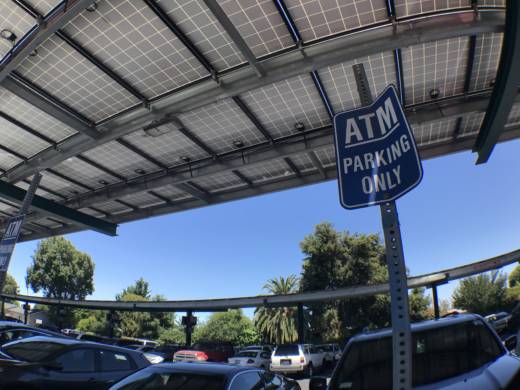Dinan says he has been asking Wells Fargo for years now to set up a branch office or ATM in East Palo Alto. So far, he hasn’t gotten a response. This summer, he decided to start an online petition, which he reads aloud:
“We call on Wells Fargo to both provide ATMs and a branch office in East Palo Alto, and to give the same level of service to residents of East Palo Alto that is provided to residents in Palo Alto, Menlo Park and other neighboring communities.”
When we contacted Wells Fargo about the petition, they sent us this statement:
“We continuously evaluate our branch network, and our physical distribution strategy is driven by customer behavior. While branches continue to be important in serving our customers’ needs, our investment in digital has also enabled us to seamlessly serve our customers online and in our mobile apps, and their growing usage of mobile banking for their day-to-day banking needs continues to reduce transactions in our branches.”
It wasn’t always this way in East Palo Alto. Residents like Eric Cody remember when there was a Bank of America where the McDonald’s now sits on University Avenue. And in 2011, the only remaining bank branch, California Bank & Trust, closed. According to news reports at the time, the bank was unable to turn a profit.
But Maeve Elise Brown, executive director of Housing and Economic Rights Advocates, says in the case of Wells Fargo, they’re missing the point. Having a presence in a community, she says, is just as important.
“It’s not the same as having a banker who knows you personally, based on knowledge about who you are and how you function in the community and wants to extend you credit. Not just, “Hey this person deposited $5,000 a month for the last year,’ “she says.
This is reflected, Brown believes, in the lack of mortgages that black and Latino people have applied for and are granted in East Palo Alto.
A search through a database maintained by the Consumer Financial Protection Bureau found that in the last four years only about 33 of the more than 400 mortgages issued in the city have been granted to black and Hispanic borrowers, a population that makes up about 80 percent of the city.
The lack of banking options, says Brown, is a holdover from the region’s racist past — when segregation and redlining were pervasive. In 2000, for instance, the city filed a lawsuit alleging that American Savings Bank had illegally discriminated against East Palo Alto residents on the basis of race. America Savings Bank later settled the lawsuit with the city.
Brown says one damaging impact of living in a bank desert is that, when there aren’t bank branches around, people are forced to find other options.
“We’ve seen payday lenders and other high-cost lenders who make themselves immediately available by being physically present in communities,” Brown says.
According to a Pew Charitable Trust report, the average payday loan borrower spends more than $500 a year just on interest. Resident Mark Dinan says all of this is perplexing in a city that’s now booming.
“It’s kind of bizarre. I mean look at a map,” Dinan says. “We have Four Seasons, we have Target. We have two Starbucks, we have IKEA, Home Depot. Any of these places could have an ATM inside.”
A few dozen people have signed Dinan’s petition, and others have shown support on Facebook. It’s time that East Palo Alto, he says, be given the same options as its neighbors.

